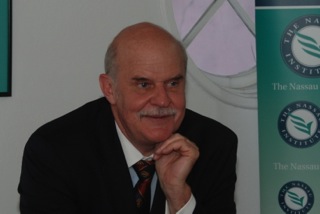 First published at Forbes.com and posted here with the kind permission of the author.
First published at Forbes.com and posted here with the kind permission of the author.
After internal leaks and disclosures two of the most powerful agencies of the U.S. government, the Internal Revenue Service and the National Security Agency, are under increased scrutiny. Will the same happen to the more independent but still secretive Federal Reserve System? A new thriller, “Hidden Order,” which focuses on the Fed and is written by best-selling author Brad Thor, will fuel speculation about misdeeds at the powerful monetary authority. Going after the Fed, however, is not easy. Incentives to protect the status quo are even stronger than at the IRS or the NSA.
We are approaching the first anniversary of the passage of H.R. 459, the Federal Reserve Transparency Act, which called for audits of the discount policies, the funding facilities, the open market operations, and the Fed agreements with foreign bankers. The bill was passed 327 to 98. Ninety-seven of the votes to protect the Fed came from Democrats. The bill remains stuck in the Senate.
Transparency in monetary affairs is an issue of justice and morality, not only economics. Several of the first books devoted to economics focused on the perils of government monetary manipulation and were written by moralists of the late middle-ages. Oresme in Italy, Copernicus in Poland, and Juan de Mariana in Spain were prime examples. Oresme wrote: “The stamp on money is a sign of the honesty of its material . . . to change this is to falsify the money.” Copernicus, better known as a scientist than as an economist and canon, argued that although everyone is concerned about social divisiveness, mortality, and the sterility of the land, only the most learned people are concerned about monetary debasement. Its ill effects happen so gradually, that few notice them, especially with paper money. Mariana argued that easy money was like a drug, in the short run it might cause pleasure, but has devastating effects in the longer run.
Most of the great economists of the 20th century, not only Milton Friedman, spent considerable amount of time on their monetary writings. Ludwig von Mises, F. A. Hayek, and the Frenchman Jacques Rueff devoted several books to the topic. Although they paid attention to some moral aspects, they stressed the negative economic impact of price inflation. They also focused on the importance of keeping the monetary system free from political manipulations. F. A. Hayek published a list with country data about the “Destruction of Paper Money” which took place between 1950 and 1975. It appeared in the appendix of his “Denationalization of Money” (pp. 136-137, IEA, London: 1976). The destruction of the value of paper money in the 60 countries listed by Hayek ranged from 99% to 40%. Inflation gave an impetus to reformers and since then, the inflationary trend reversed.
Economic freedom indices produced by major think tanks, such as The Heritage Foundation and the Fraser Institute (Canada) include measures of “monetary freedom” and “sound money.” Despite the differences in their methodology, both indices show very high degrees of monetary freedom and sound money. In the Fraser index, for example, during this last decade, on a 1-10 score, where 10 is the best, the United States and the Eurozone countries score between 9.3 and 9.5. The Heritage Foundation scores are less generous (7.6 for the U.S. and 8.1 for Eurozone). As an economist, I have doubts about how these measurements conform to the reality of sound money and monetary freedom, not to mention doubts about how inflation is measured in modern times.
If we can’t count yet on price increases to mobilize public opinion to battle the current statist monetary system and scrutinize the Fed, is it possible to rely on arguments describing the immorality of the manipulation of money and credit? Making a credible case against credit manipulation is more difficult than making a case against price inflation. It requires a more elaborate analysis and getting into specifics: which banks and credit institutions were benefited, which suffered? Within banks, which executives lobbied for privileges and received big bonuses? It is not enough to blame “corporate welfare,” “crony capitalism” or the “banksters.” Sound money advocates should describe and have access to data from the Federal Reserve to study how they distributed their favors.
Some analysts with libertarian and conservative leanings might fear that if they highlight the names of private sector actors who reap profits thanks to their privileged relationship with the government, they might provide ammunition to those who want even more government intervention in the economy. This is a reasonable concern, but it is a handicap for those who want to defend the free enterprise system, including banking, on moral grounds.
This December the Fed will celebrate its 100th birthday. Under their authority, the dollar lost 98% of its value. Nevertheless, unless price inflation kicks in or a major scandal is revealed, it will not be easy to foil its party.
Dr. Chafuen is president of Atlas Economic Research Foundation. He is a member of the board of advisors to The Center for Vision & Values and a trustee of Grove City College, and the president and founder of the Hispanic American Center of Economic Research. He serves on several boards including the Chase Foundation of Virginia, the Acton Institute, the Fraser Institute (Canada), and is an Active Honorary Member of the John Templeton Foundation.

